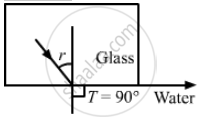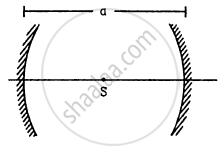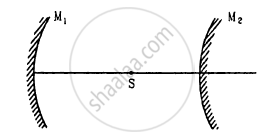Advertisements
Advertisements
प्रश्न
Light is incident from glass (μ = 1.50) to water (μ = 1.33). Find the range of the angle of deviation for which there are two angles of incidence.
उत्तर
Given,
Refractive index of glass
\[: \mu_g = 1 . 5 = \frac{3}{2}\]
Refractive index of water \[: \mu_g = 1 . 5 = \frac{3}{2}\]
Refractive index of water \[: \mu_w = 1 . 33 = \frac{4}{3}\]
As per the question,
For two angles of incidence,
1. When light passes straight through the Normal,
⇒ Angle of incidence = 0°
⇒ Angle of refraction = 0°
⇒ Angle of deviation = 0°
2. When light is incident at critical angle θc,
\[\frac{\sin \theta_c}{\sin r} = \frac{\mu_w}{\mu_g}\](since the light is passing from glass to water)
\[\Rightarrow \sin \theta_c = \frac{8}{9}\]
\[\Rightarrow \theta_c = \sin^{- 1} \left( \frac{8}{9} \right) = 62 . 73^\circ \]
⇒ Angle of deviation
=90° − θc
\[= 90 - \sin^{- 1} \frac{8}{9}\] = 37.27°
Here, if the angle of incidence increased beyond the critical angle, total internal reflection occurs and deviation decreases.
Therefore, the range of angle of deviation is in between 0 to 37.27° or \[\cos^{- 1} \left( \frac{8}{9} \right)\]
APPEARS IN
संबंधित प्रश्न
Give a scientific reason:
Danger signals are red in colour.
Write two points of difference between the phenomena of interference and diffraction.
Describe briefly using a diagram how sunlight is polarised ?
The image formed by a concave mirror
A convex lens is made of a material having refractive index
\[1 \cdot 2\] Both the surfaces of the lens are convex. If it is dipped into water (μ = 1.33), it will behave like
A concave mirror forms an image of 20 cm high object on a screen placed 5.0 m away from the mirror. The height of the image is 50 cm. Find the focal length of the mirror and the distance between the mirror and the object.
A concave mirror has a focal length of 20 cm. Find the position or positions of an object for which the image-size is double of the object-size.
A point source S is placed midway between two converging mirrors having equal focal length f as shown in figure. Find the values of d for which only one image is formed.
A converging mirror M1, a point source S and a diverging mirror M2 are arranged as shown in figure. The source is placed at a distance of 30 cm from M1. The focal length of each of the mirrors is 20 cm. Consider only the images formed by a maximum of two reflections. It is found that one image is formed on the source itself. (a) Find the distance between the two mirrors. (b) Find the location of the image formed by the single reflection from M2.

Locate the image of the point P as seen by the eye in the figure.

An optical fibre (μ = 1.72) is surrounded by a glass coating (μ = 1.50). Find the critical angle for total internal reflection at the fibre-glass interface.
Explain: ‘How is a rainbow formed’?
Answer the following question in detail.
Is it possible to see primary and secondary rainbow simultaneously? Under what conditions?
Pick the wrong answer in the context with rainbow.
State any one difference between a primary rainbow and a secondary rainbow.
| Case study: Mirage in deserts |
 |
|
To a distant observer, the light appears to be coming from somewhere below the ground. The observer naturally assumes that light is being reflected from the ground, say, by a pool of water near the tall object. Such inverted images of distant tall objects cause an optical illusion to the observer. This phenomenon is called mirage. This type of mirage is especially common in hot deserts. Based on the above facts, answer the following question : |
In an optical fibre, if n1 and n2 are the refractive indices of the core and cladding, then which among the following, would be a correct equation?
| Case study: Mirage in deserts |
 |
|
To a distant observer, the light appears to be coming from somewhere below the ground. The observer naturally assumes that light is being reflected from the ground, say, by a pool of water near the tall object. Such inverted images of distant tall objects cause an optical illusion to the observer. This phenomenon is called mirage. This type of mirage is especially common in hot deserts. Based on the above facts, answer the following question: |
The following figure shows a cross-section of a ‘light pipe’ made of a glass fiber of refractive index 1.68. The outer covering of the pipe is made of a material of refractive index 1.44. What is the range of the angles of the incident rays with the axis of the pipe for the following phenomena to occur.

A short pulse of white light is incident from air to a glass slab at normal incidence. After travelling through the slab, the first colour to emerge is ______.
